MULE CROSSING: Equine Behavior: Look Who’s Talking! Part 3
By Meredith Hodges
In Part 1 of Equine Behavior: Look Who’s Talking, we discussed the evolution of man’s self-discovery and how he applied this to his approach to equines. If we want to manage our equines in a healthy way and accomplish even the most basic performance with them, there is much to consider during the training process. In Part 2 of Equine Behavior: Look Who’s Talking, we learned that equines are honest in their nature, and produce quick and honest reactions to a stimulus. Therapeutic Riding provides and exemplary teaching experience for both the human and the equine. Those of us with our own equines can now derive much more from our relationships with equines than we ever thought possible.
During centuries of use, equines have been asked to perform many tasks, as they have always been essential in agriculture, for transportation in cities and as fighting partners in the military. People who worked regularly with these animals had an appreciation for their overall health and longevity. Although people were limited by their own experience, they would generally provide the best possible care because the equine was an integral part of their economy. Many horses, and most mules and donkeys, worked hard to build this world and support people in their endeavors. It is always amazing when one realizes the expanse of equines’ contributions to our wealth and welfare.
Original Dressage training was concerned with the systematic conditioning of the body of the horse in a way that would make him a durable and viable war partner for soldiers. The horse was revered and allowed time for his body to mature and grow slowly. The training followed suit, yielding a healthy and formidable opponent in any competition. This goal was achieved only when the animal was trained in good posture, and given adequate time to complete each stage of training as his own potential dictated.
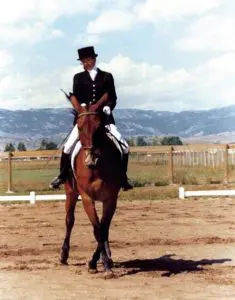 When proper attention is given to the development of balanced, postural core muscle strength from the very beginning, the equine develops strength symmetrically throughout his body as he grows. Muscles are stressed and relaxed at critical intervals, allowing for healthy mental, physical and emotional growth. When the equine feels good in his body, it clears his mind to concentrate on his performance. The result is an equine that is happy in his work and in his world.
When proper attention is given to the development of balanced, postural core muscle strength from the very beginning, the equine develops strength symmetrically throughout his body as he grows. Muscles are stressed and relaxed at critical intervals, allowing for healthy mental, physical and emotional growth. When the equine feels good in his body, it clears his mind to concentrate on his performance. The result is an equine that is happy in his work and in his world.
Colonel Alois Podhasky (1898-1973), former head of the Spanish Riding School in Vienna, Austria said, “I’ve got time!…We can only achieve the highest goals in the art of riding when we increase our demands on the horse in a systematic manner.” (1)
The same holds true with any athlete. No animal can perform at their highest level and remain healthy without building the body correctly over a significant period of time. Forcing things and moving too fast through training levels does not allow healthy athletic conditioning to take place. This conditioning art is becoming lost in the economic world today as equines are no longer being used as a necessity. They have become a hobby, or a sport in more developed countries, and are an economic necessity only in Third World countries that are not equipped to provide the extensive care that a healthy equine demands.
 Dressage training has evolved from a useful tool to strengthen and balance a useful horse to just another name in Big Business. Today, equines are thought of as economic commodity, or a breeding investment, and are used in events such as Reining, Cutting, Stadium Jumping, Racing, Steeplechase, Eventing, Hunting, Dressage and just-for-pleasure riding. Monetary investment is high, and never was the old adage of “horse poor” more prevalent than now!
Dressage training has evolved from a useful tool to strengthen and balance a useful horse to just another name in Big Business. Today, equines are thought of as economic commodity, or a breeding investment, and are used in events such as Reining, Cutting, Stadium Jumping, Racing, Steeplechase, Eventing, Hunting, Dressage and just-for-pleasure riding. Monetary investment is high, and never was the old adage of “horse poor” more prevalent than now!
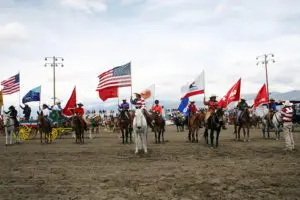 Owners can expect to spend thousands of dollars in a year for no more than a pleasure riding equine, and the cost increases with the status of the activities. The cost of supporting an equine provides economic success to a multitude of businesses such as feed stores, tack and equipment, truck and trailer sales, drug companies, motels, gas stations, county fairgrounds, breed registries, brand inspection, clothing stores, veterinarians, farriers, and the list goes on.
Owners can expect to spend thousands of dollars in a year for no more than a pleasure riding equine, and the cost increases with the status of the activities. The cost of supporting an equine provides economic success to a multitude of businesses such as feed stores, tack and equipment, truck and trailer sales, drug companies, motels, gas stations, county fairgrounds, breed registries, brand inspection, clothing stores, veterinarians, farriers, and the list goes on.
In any business, moving product faster is always better because it decreases overhead costs. Anything long-lasting takes more expense to produce and does not afford repeat customers as often. The same product is therefore, less valued. But good business sense is in direct opposition to what is actually good and healthy for the equine. Good business sense is what drives people to train equines faster, and why people ask young equines to perform way beyond their level of capability, to promote a faster sale of the equine, which ultimately results in the untimely demise of the equine.
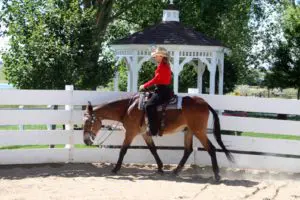 Breeding for bigger, better and faster equines, has given people the false idea that these horses perform almost solely from their heredity. This has changed how they are being trained and judged. Today, many equine competitions are no longer judged by an expert who really knows the definition of correct movement. We are inundated with terminology from the Masters that is most often misunderstood and distorted.
Breeding for bigger, better and faster equines, has given people the false idea that these horses perform almost solely from their heredity. This has changed how they are being trained and judged. Today, many equine competitions are no longer judged by an expert who really knows the definition of correct movement. We are inundated with terminology from the Masters that is most often misunderstood and distorted.
For instance, collection is defined by the United States Equestrian Federation as, “a. to further develop and improve the balance and equilibrium of the horse which has been more or less displaced by the additional weight of the rider, b. to develop and increase the horse’s ability to lower and engage his hindquarters for the benefit of lightness and mobility of his forehand, and c. to add the ‘ease and carriage’ of the horse and to make him more pleasurable to ride.”
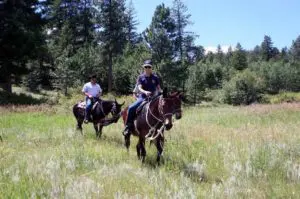 To those who are not schooled in Dressage, collection can mean a lot of things that are contrary to the actual definition, including the belief that it means to merely break at the poll and arc the head and neck. People also believe that an equine is on the bit if he arcs his head and neck and flexes at the poll. What this actually means is that the equine has taken contact with the bit, and can feel the hands of the rider through the reins, and respond lightly and obediently whether his head and neck are arched or not. Vertical flexion is the result of correct collection that involves the entire body of the equine, when the equine is flexible from head to tail with the hindquarters properly engaged. It is not the act of bringing the equine’s chin to his chest. Lateral flexion is when the equine bends his whole body through his rib cage to the arc of a circle, and is not just bending his head and neck to your knee.
To those who are not schooled in Dressage, collection can mean a lot of things that are contrary to the actual definition, including the belief that it means to merely break at the poll and arc the head and neck. People also believe that an equine is on the bit if he arcs his head and neck and flexes at the poll. What this actually means is that the equine has taken contact with the bit, and can feel the hands of the rider through the reins, and respond lightly and obediently whether his head and neck are arched or not. Vertical flexion is the result of correct collection that involves the entire body of the equine, when the equine is flexible from head to tail with the hindquarters properly engaged. It is not the act of bringing the equine’s chin to his chest. Lateral flexion is when the equine bends his whole body through his rib cage to the arc of a circle, and is not just bending his head and neck to your knee.
All of these movements take many years to cultivate if they are to be done correctly. There are specific exercises to do at every stage to make sure that the equine is developing properly and executing these movements on his own, with only the most subliminal support from the rider’s aids. Most equines that are shown today are not engaged sufficiently behind and are doing “High School” movements out of good equine posture. They are clearly on the forehand and unbalanced.
If one is to develop the equine in a sound manner, then one must learn to appreciate the smaller victories at each stage of training and during every lesson. One needs to learn to appreciate the incredible ways that one can affect balance and movement during Leading Training. Leading Training can teach the equine good balance, proprioception (body awareness) and regularity of the footfall patterns.
The equine will become strong and balanced in his core muscles (and all the elements that support his skeleton) using simple tasks that appear in the Hourglass Pattern and later through obstacles for coordination. Only after your equine is able to take responsibility for his own balance and negotiation of these movements should he be asked to go to the Round Pen to learn to balance on a circle at all three gaits. Only then will he be able to maintain equal weight over all four feet, bend properly through his torso and not lean like a motorcycle.
Only after he is able to sustain his own balance on the circle through all three gaits (walk, trot and canter), stop, back and reverse, and has been Ground Driven long enough to submit lightly to the bit through all movements, should he be mounted and asked to carry a rider. Even lunging on the lunge line should first be taught in the Round Pen, so when you do lunge him in an open area, he will know the cues to keep him on the circle and has the ability to balance himself.
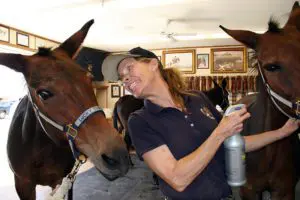 You would teach him to lunge on the lunge line in the Round Pen first with enough slack in the line so it drags on the ground as he circles. Keep a slightly open fist on the line and close your first as the outside front leg comes forward into suspension. He will feel this pressure and bring that front leg onto the circle instead of going straight forward with it. This is the cue you will use when lunging him on the line in the open arena.
You would teach him to lunge on the lunge line in the Round Pen first with enough slack in the line so it drags on the ground as he circles. Keep a slightly open fist on the line and close your first as the outside front leg comes forward into suspension. He will feel this pressure and bring that front leg onto the circle instead of going straight forward with it. This is the cue you will use when lunging him on the line in the open arena.
The equine that has had the benefit of postural core strength training will be safer on the trail and flawless in the show ring. If you take the time to develop your equine properly, during these seemingly boring tasks, you might very well discover a healthier and happier YOU!
It is difficult for judges without roots in agriculture to conflict with the roar of the crowds at shows as they see fancy movements. If the judge does not hold true to what is truly correct and allows himself to be swayed by the audience, the integrity of the equine industry is lost. Our equines will continue to suffer at the hands of ignorance because there are no clear standards by which to educate people. The equine that is properly trained should appear to be performing of his own volition. If he does not appear this way, and is constrained or forced, he is not in correct posture or balance and cannot perform correctly. The integrity of his movement is lost and the longevity of his life is compromised.
When you take the time to feed, maintain and train your equine as he should be trained as an athlete, his personality will begin to emerge. You will be surprised at the relationship you will have with him and the wondrous sensations you can feel when you are in true harmony with him. You will no longer be just an observer, but rather, a friend and partner in performance, and in life! You have laid the foundation for both of your personalities to grow in the most positive way and will develop the deepest bond possible.
To learn more about Meredith Hodges and her comprehensive all-breed equine training program, visit LuckyThreeRanch.com or call 1-800-816-7566. Check out her children’s website at JasperTheMule.com. Also, find Meredith on Facebook, YouTube, Pinterest, Instagram, MeWe and Twitter.
Covered in TRAINING MULES & DONKEY: A LOGICAL APPROACH TO TRAINING, TRAINING WITHOUT RESISTANCE, EQUUS REVISITED and A GUIDE TO RAISING & SHOWING MULES at www.luckythreeranchstore.com
© 2011, 2016, 2024 Lucky Three Ranch, Inc. All rights reserved.
1Tug of War: Classical vs. Modern Dressage by Dr. Gerd Heuschmann, pg. 38, Copyright © 2006 Wu Wei Verlag, Schondorf, Germany, English translation Published by Trafalgar Square Books, North Pomfret, Vermont, 05053, USA 2007 (Footnote: Podhasky, Alois, ibid: Mossdorf, Carl Friedrich (1989), p. 142)




